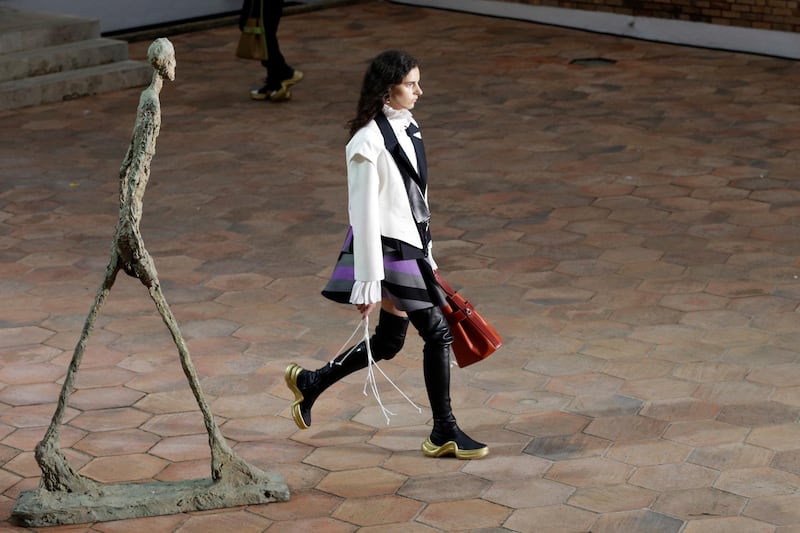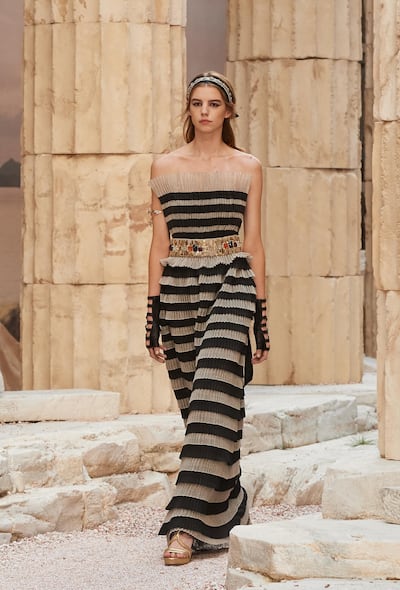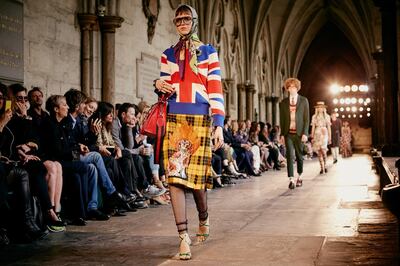- Search Please fill out this field.
- Newsletters
- Sweepstakes
- The Destinations Issue The Beauty of Alicia Keys We Put Keys Soulcare's New "It's Like Skin" Tint to the Test How Important Is That Vacation Really? The Curious Case of the Cruise Collection 12 Summer Reads That Prove Travel Is a State of Mind Editors' Picks: Where We're Going and What We're Wearing This Summer CLOSE Part of The Destinations Issue

The Curious Case of the Cruise Collection
How the hard-to-define bridge between fall and spring became fashion's most fanciful season.
Getty Images/ Amanda Lauro
Regardless of the weather, fashion has two guaranteed seasons: spring and fall. See one yearly cycle all the way through, and you’ve more or less seen them all — florals (groundbreaking!) and bright colors for spring/summer, structured jackets, and a dark color palette for fall/winter. So too, the backdrop of each season remains remarkably consistent when the industry’s most powerful and best-dressed flock to major cities around the world to see models walk the same stark runways. As any insider will tell you, Fashion Weeks can get monotonous. There is, however, one notable exception: cruise.
This mercurial annual collection drop (and the fashion events that come along with it) is deliciously unpredictable. Unlike the year’s two major reveals, not every brand does a cruise collection, and many skip the full-on show. Those that do are usually older, established luxury brands — Chanel, Louis Vuitton, Moschino, Gucci — and they go all-in.
The cornerstone of the cruise collection is a curious blend of wearable art and wild spectacle, designed to fill the gap between spring and summer with vacation-ready party wear. Launched in some of the world's most fantastical locations, brands rent out palaces, hire fire dancers, and dock fully functional ocean liners to serve as backdrops for their collections.
Getty Images
Debuting in May and usually shoppable in time for the holidays, cruise (also styled as "resort") has been escapism-adjacent since the beginning. The concept started with Gabrielle “Coco" Chanel , who, in 1919, presented a collection of lightweight womenswear suitable for sunny getaways to distant locales. The show, put on in Paris, shocked the industry with its seasonless-ness, but also delighted the jet-set crowd in Europe and the States. After all, what's not to love about a collection that's equal parts party and vacation?
Designer imaginations run wild, and models walk runways specifically made for cruise collections shows. The lucky few editors, buyers, and influencers invited to watch the spectacle in person are flown to each far-flung location to do so. If there’s any magic left in the fashion industry, it lives in the cruise collection, and has for almost 100 years.
The clothes themselves, unencumbered by practicality or the weather (remember, these collections cater to tropical, ski, and holiday party dressing), often show what happens when prestige fashion lets its hair down: Dresses explode with sequins, and heritage touchstones like Chanel’s eponymous tweed become cotton candy fever dream bikinis.
In the past decade, designers have started to take the idea of a getaway more literally, developing cruise collections that are vacations unto themselves. In 2014, Karl Lagerfeld had an island built in Dubai as a backdrop for Chanel’s show. In 2018, the cruise runway for Chanel was a 148-foot literal cruise ship built inside the Grand Palais in Paris. The year before that? Karl Lagerfeld couldn't find a venue in Greece he liked , so he reconstructed the Temple of Poseidon in Paris.
Each year, the ante is upped as designers compete — not necessarily with one another, but with the fantasies they’ve built in years past. Many fashion houses, Chanel notwithstanding, iterate on a particularly extravagant mood or theme. Louis Vuitton, somewhat new to the cruise collection game, held its first cruise runway show at the Palace Square in Monaco, followed by Palm Springs in 2016, before establishing a pattern of showing at modern art museums. Since then, they've debuted at the Niterói Contemporary Art Museum in Rio de Janeiro, Brazil, as well as museums in Kyoto, Japan, and the South of France.
Dior, for its part, favors palaces and grand arenas (Palais Bulles, Blenheim's Palace, the Piazza del Duomo, and the Panathenaic Stadium), while Gucci, under Alessandro Michele, opted for expansive spaces more readily available to the public: West 22nd Street in Manhattan, Westminster Abbey, Promenade Des Alyscamps.
Against such magnificent backdrops, clothes have to shout to be heard, and most cruise collections are some of the loudest (or most experimental) expressions of their designers’ voices. Clothing that started as lightweight separates, suitable for poolside lounging, evolved into dramatically imaginative looks, from technicolor swimwear to jewel-encrusted mini skirts and hand-embroidered sheer jackets dripping in flowers.
Cruise, at its best, can be pure fantasy. Neon signs served as the glittering backdrop for Moschino’s 2018 cruise collection, which sent dazzling showgirl costumes down the runway. Designer Jeremy Scott’s penchant for blending pop culture, kitsch, and Americana turned the volume all the way up to 11. And yet, for every swimsuit festooned with life-size doves, there was a simple high-cut one-piece with a single graphic print (worn by Hailey Bieber, of course). The moment encapsulated another curious element of cruise collections: surprisingly functional pieces, like swimwear, often pop up between and amidst other fanciful creations.
While these collections create space for designers to throw everything they’ve got into an escapist spectacle, the looks on the runway aren’t all just for show, so to speak. You can still spot tops, dresses, and skirts that are more ready to wear than what you’d see in an actual ready-to-wear collection. The reasoning is simple: Not all devoted shoppers live in places where the heavy outerwear and lush layers of fall/winter collection are viable options. The lighter-weight fabrics and ‘fits in cruise collections aren’t just playful. They’re profitable. In fact, Chanel's President of Fashion once reported that, in a single year, its cruise collection was responsible for 30% of its total revenue .
By 2019, cruise collections reached a fever pitch. Models in Dior wore ethereal gowns and walked backlit by massive bonfires outside the El Badi Palace in Marrakesh, Morocco. Louis Vuitton’s models strutted through JFK airport in glittering crop tops that looked like futuristic robot armor. During the Gucci show in Musei Capitolini, Rome, the vibe was ‘70s opulence, sequined, metallic, gender-bending, and adorned with the kinds of headdresses, crowns, and bangles you might see on gladiator royalty. The question on the mind of many folks in fashion was simply, how are they going to top this?
Then, a pandemic happened, and fashion came to a standstill. In 2021, as the world began slowly turning again, the landscape of the industry looked different. Chanel, Gucci, Armani, Prada, and Versace all canceled or postponed their cruise shows, with some fashion houses opting to shutter the concept altogether. Meanwhile, others are rethinking the very spectacle that made this entry on the fashion calendar so exciting.
With the climate crisis more front of mind than ever before, traveling for the sake of watching a runway show — the very heart of the modern cruise collection — has come under scrutiny. There may come a time when editors and influencers aren’t jetted off to see the spectacle of a cruise collection come to life.
This year at least, cruise collections have shown glimmers of their former grandeur. Outside of Gyeongbokgung Palace in Seoul, South Korea, models walked the runway for Gucci in gauzy dresses that would have been fully sheer in places were it not for the scuba suits worn underneath. On Isola Bella, an island on Italy’s Lake Maggiore, models at Louis Vuitton wore pastel gowns shaped with hoop skirts at the hems, giving them the look of decadent French pastries, with bejeweled jackets in the shape and gleam of carapaces. Collections presented in Mumbai, India, Rio de Janeiro, Brazil, and Mexico City, Mexico, captured the escapism and daring imagination of years past.
The spectacle is never far off, but even so, the most recent iteration of cruise slipped in a few practical moments, too. At the Alberta Ferretti Resort 2024 show, you’d be forgiven for missing the very wearable slip dresses that went down the runway under hooded, full-length sequined capes. Similarly, Gucci’s gauzy, sheer dresses could easily be worn to a dinner party — even if the models were decked out in less-than-practical scuba suits underneath. But it’s this juxtaposition, marketable and magnificent, that makes cruise collections such a joy to watch.
At its core, cruise is fashion at its most decadent. While it does serve a practical purpose, its essential nature is to delight and transport us. How that journey and joy will look in years to come is still up for debate, but for now, it seems like collections will remain dreamily, passionately curious one-offs with dramatic styling and explosive showmanship.

The Destinations Issue
Related articles.
- Environment
- Road to Net Zero
- Art & Design
- Film & TV
- Music & On-stage
- Pop Culture
- Fashion & Beauty
- Home & Garden
- Things to do
- Combat Sports
- Horse Racing
- Beyond the Headlines
- Trending Middle East
- Business Extra
- Culture Bites
- Year of Elections
- Pocketful of Dirhams
- Books of My Life
- Iraq: 20 Years On
The concept of the cruise collection explained
Initially created for a select group of wealthy clients taking mid-winter holidays, the cruise collection has evolved into one of the most important of the year.

The Louis Vuitton Cruise 2019 Collection was presented at the Maeght Foundation art collection in Saint Paul de Vence last month. AP
S ometimes called cruise, or pre-spring, or resort, or even holiday, this is the collection on everyone's lips. And with brands in the midst of showing their cruise 2019 collections, it seems like an ideal time to take a closer look at what all the fuss is about.
Cruise is a mid-season, mini-fashion collection, essentially designed for those who winter onboard a yacht. At least that’s how it all started, when, in 1919, Gabrielle Chanel realised that her wealthy clients were taking mid-winter holidays in the Mediterranean and required a new wardrobe for their travels. Chanel ran up a collection of lightweight, easy-to-wear pieces suitable for a trip on a steamship, and the world’s first cruise collection came into being.
“[Cruise collections] really did start as a small capsule collection of clothing for a cruise or resort style vacation somewhere warm and sunny,” Sass Brown, founding dean of the Dubai Institute of Design and Innovation, says. “Inevitably, they were aimed at the high-end consumer who could afford to take a cruise outside of the usual summer vacation period.”
Fast-forward 100 years and the world is a very different place, with a crowded fashion market, online shopping and a new breed of informed, impatient and demanding consumer. To attract the modern shopper's attention, brands must deliver new and exciting products in fresh and engaging ways. The standard model of just two collections a year – spring/summer and autumn/winter – feels increasingly out of step with what customers actually want.Under the two-season model, the arrival of stock in-store is dictated more by production cycles than by when the customer might need it. "It used to be usual for a brand to deliver spring/summer in January and fall/winter in July; times of the year when much of the western hemisphere is not nearly ready to purchase them," Brown says. Frustrated with such a disconnection, savvy consumers began looking to cruise, which, although still aimed at wealthy holidaymakers, offered a new approach that delivered a smaller range, but one that was less season-specific and more in tune with modern customers' lifestyles.
"With the speeding-up of the fashion cycle," Brown says , "there is a far greater expectation to continuously show something new, year-round, to consumers and media. It has become increasingly important for brands to fulfil that expectation to maintain exposure. The inevitable shortened attention span means brands have to keep pace and can no longer remain relevant with just two collections a year."
Cruise collections are now generally unveiled in May, to go into stores in November, after the main winter collection has arrived. Customers have found that this offering of lighter pieces folds seamlessly in with their already purchased winter items, while for markets like the Middle East, where autumn/winter collections are largely irrelevant, cruise is a perfect solution.
Snapped up by an ever-growing number of clients, resort collections have become increasingly important for business because “they enable the spread of cash flow across more than two main seasons”, says Brown. “With the globalisation of branding, a pre-collection also allows brands to appeal to a broader, more diverse global audience, who deal with a diversity of climates.”

Some brands report that cruise now represents 60 per cent of annual turnover, and with the global fashion industry worth an estimated $1.2 trillion (Dh4.4tn), the figures are potentially huge. As far back as 2011, Bruno Pavlovsky, the president of fashion for Chanel, explained to WWD that cruise “now represents Chanel’s biggest and most important delivery of the year”.
Unlike the ready-to-wear spring/summer or autumn/winter shows, which are so tightly bunched into fashion weeks it becomes almost claustrophobic, there are no such restrictions with cruise collections. Taking place outside of the regular schedule, this effectively gives labels far more freedom to do as they please. Which often translates into the use of glamorous and exotic locations that feel hip and of the moment.
For cruise 2016, Louis Vuitton showed at Bob Hope’s famous home in Palm Springs, followed by the spectacular Niteroi Contemporary Art Museum in Rio de Janeiro, Brazil, for cruise 2017. For 2018, meanwhile, it headed to Kyoto. Christian Dior went to Blenheim Palace for 2017, and then Calabasas in America for 2018. Gucci, meanwhile, showed its cruise 2017 collection in Westminster Abbey, headed to Florence for 2018, and showed its latest line in Arles, France. Chanel journeyed to Seoul, South Korea, for resort 2016, and to Cuba for cruise 2017.
As Brown points out: “It is an opportunity for a brand to mix things up and keep things interesting, by doing shows in exciting and desirable locations. It also offers the brand an opportunity to differentiate the pieces from the main collection by showing them in a different location with a different flavour or style.”
The change of style often comes through as broader themed collections that are innovative but also highly wearable. From the brand’s side, while it costs money to stage these lavish shows (Business of Fashion estimates that larger houses are spending up to $10 million per event), it does mean that your best customers can be whisked away to a private location and guided through the new offering completely undistracted.
Since its inception, cruise has essentially been about grabbing attention, and the 2019 collections are proving to be no exception. For its show earlier this month, Chanel returned to the very nature of cruise, by building a life-size ship in Paris' Grand Palais, complete with a smoking funnel. Called La Pausa (after Gabrielle's famed summer home), the ship took four weeks to build off-site, and a further 15 days to construct in situ. The clothes continued the theme, offering a breezy take on boating sophistication with jaunty stripes and multiple shades of blue. It was resoundingly optimistic and, once the show was over, the whole audience was invited on board. Christian Dior, meanwhile, decamped from Paris to Chantilly, the French town famous for its lace. Despite being rained on at the open-air hippodrome, Maria Grazia Chiuri's collection was based on the style of dress of escaramuza riders, a band of famous female Mexican rodeo riders whose look of cinched waist over full skirts (a near doppelganger for Dior's own aesthetic) here came finished with riding hats and horse nose-bag sized holdalls. Peasant dresses were covered in traditional Mexican embroidery, and worn with Frida Kahlo-esque centre partings. Wide brimmed hats appeared alongside velvet riding jackets, while delicate vintage-looking prints were made into sweatshirts and full skirts, light as air.
Prada, meanwhile, upped sticks to New York for only its second cruise show, presenting an astonishing collection brimming with trademark retro-inspired patterns and unnerving colour combinations, all revisited and reconsidered. Brilliantly wearable, it seems Prada is making up for lost time.

Notably, after past seasons where cruise collections were shown in increasingly exotic global destinations, this season the focus seems very much on France, and all things French. “France has always been the home of luxury fashion, and the labels showing in France this year are predominately European and many are French. There is always greater cultural significance in the choice of location however, and France is definitely enjoying a moment right now,” says Brown.
“The young French president (Emmanuel Macron) signals positive change, and fashion is always about change,” she adds. “He is positioning France as an inclusive, forward-thinking country welcoming environmental scientists from around the world, and encouraging technology start-ups. Ian Rogers, the chief digital officer at LVMH, has compared Paris now to Shoreditch and Brooklyn in their heyday of creative explosion.”
Where better, then, to show the most significant collection of the year?
______________
[ Gucci to present spring/summer 2019 collection in Paris ]
Vuitton in starry homage to fashion's 'Amazing Grace'
Ghoulish fashion from Gucci
______________


COMMENTS
The cornerstone of the cruise collection is a curious blend of wearable art and wild spectacle, designed to fill the gap between spring and summer with vacation-ready party wear.
9. The Cruise Collection by Joliebean. Jul 6, 2023. Embrace the sun-drenched season with the new Cruise Collection, where bold patterns and vibrant colors take center stage, allowing you to make a splash with your own unique style. From the beach to the poolside, this set will inspire confidence and ignite your inner fashionista.
For Chanel’s cruise 2018 collection, right, Paris’s Grand Palais was turned into an Ancient Greek temple. Chanel. Some brands report that cruise now represents 60 per cent of annual turnover, and with the global fashion industry worth an estimated $1.2 trillion (Dh4.4tn), the figures are potentially huge.